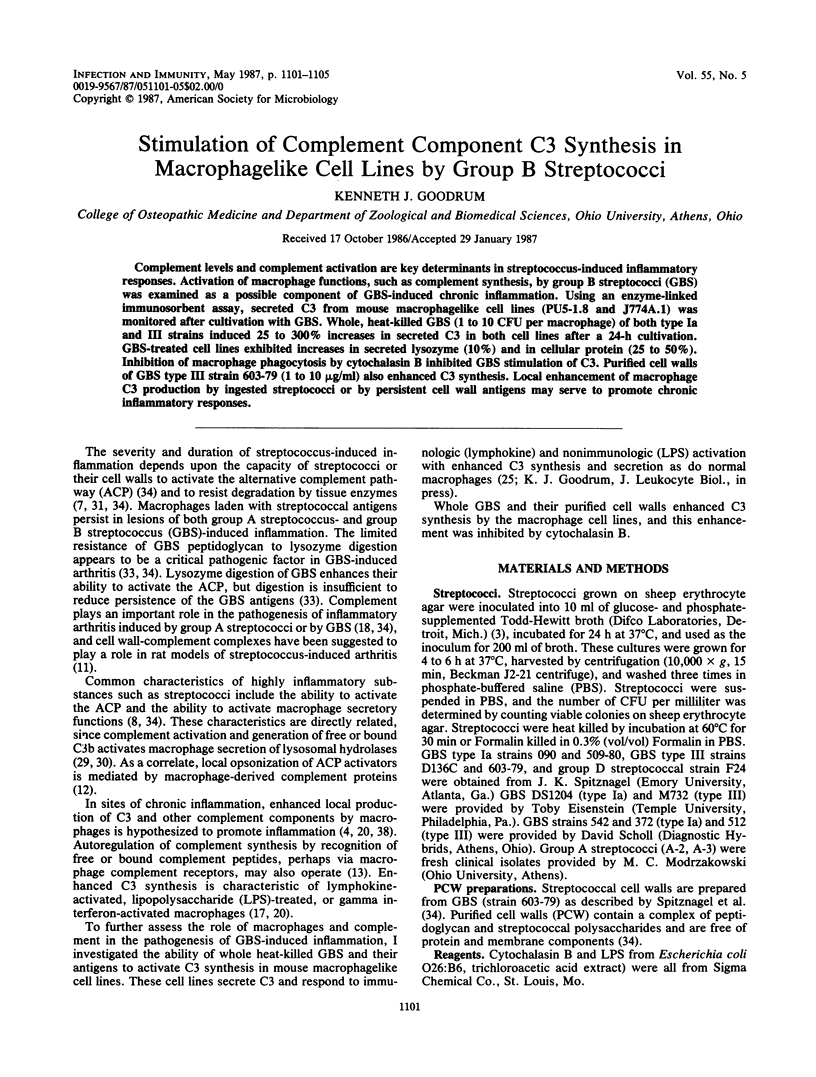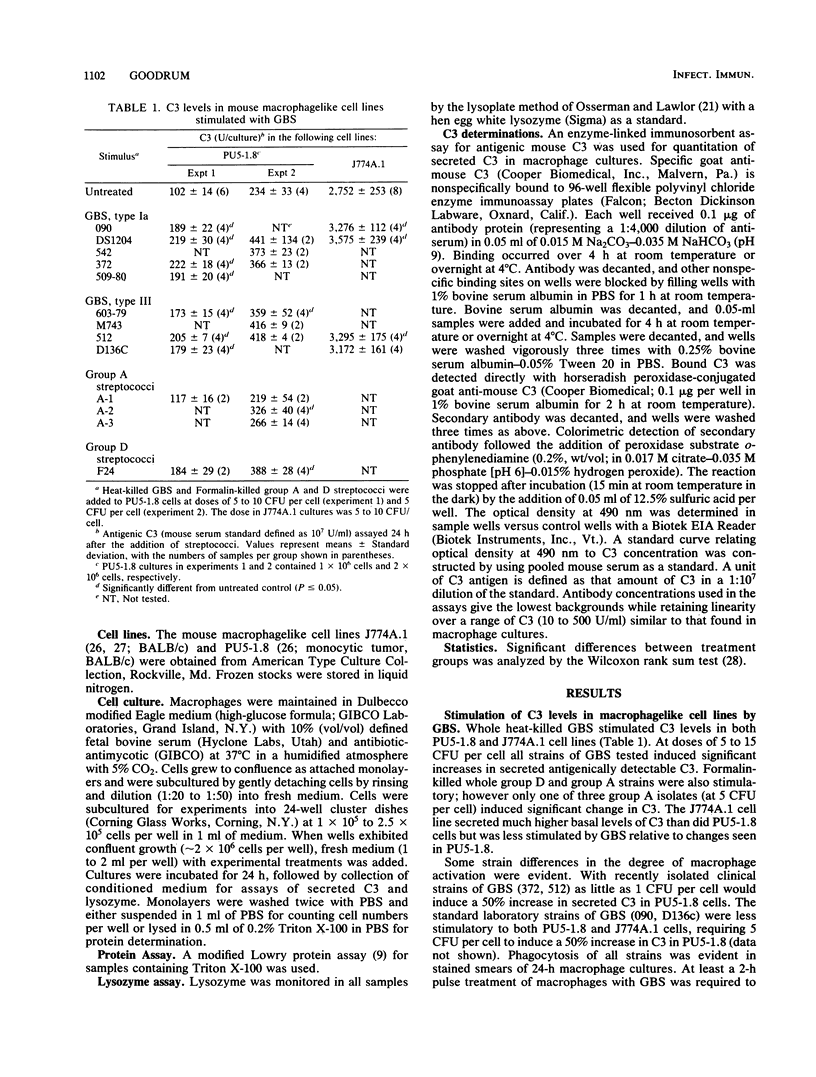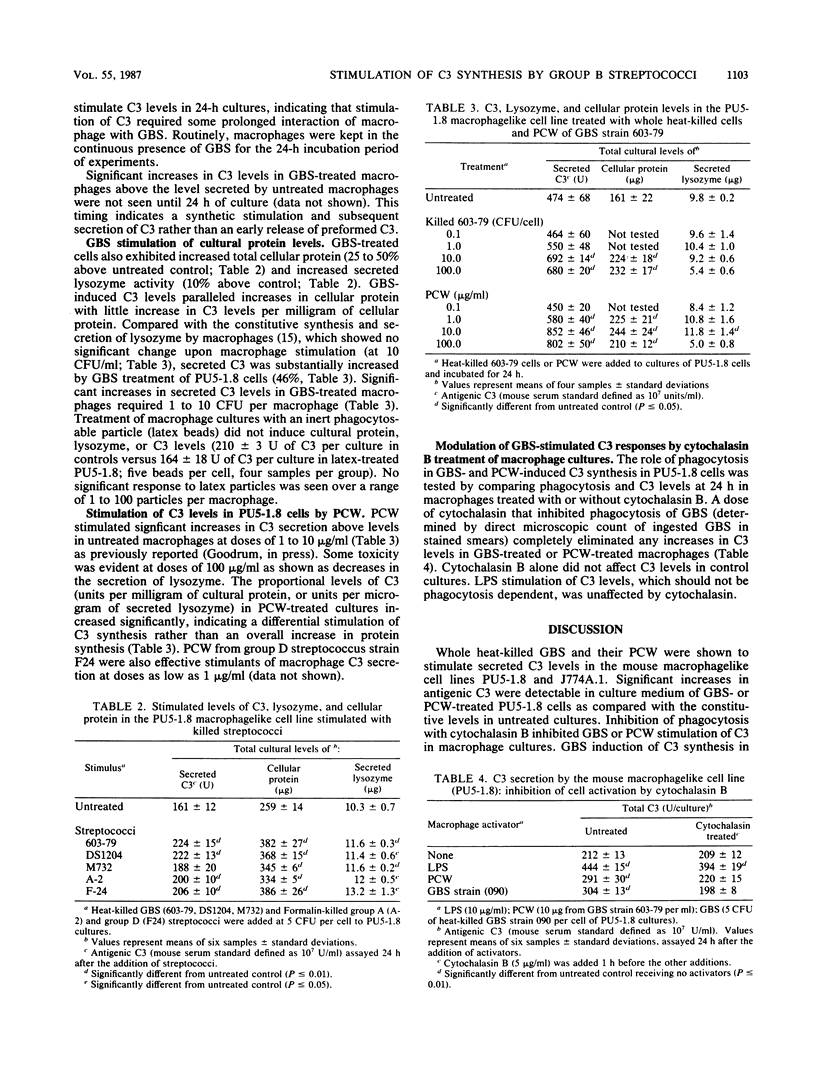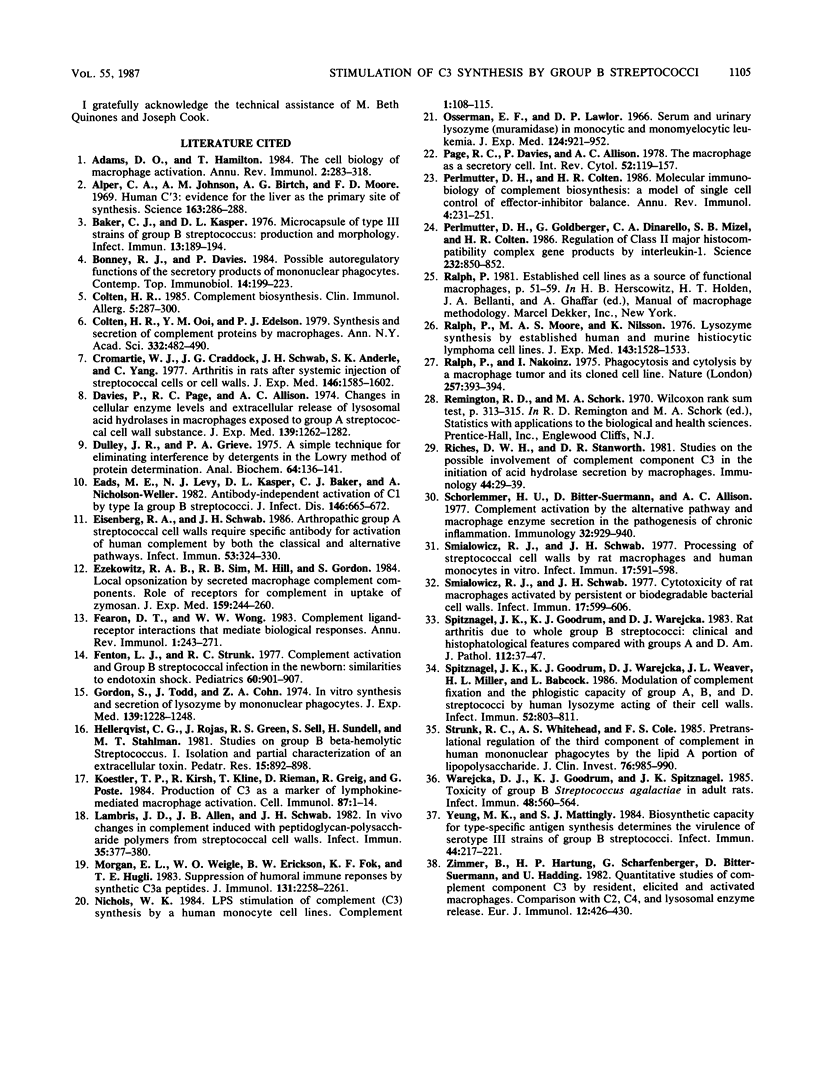Abstract
Complement levels and complement activation are key determinants in streptococcus-induced inflammatory responses. Activation of macrophage functions, such as complement synthesis, by group B streptococci (GBS) was examined as a possible component of GBS-induced chronic inflammation. Using an enzyme-linked immunosorbent assay, secreted C3 from mouse macrophagelike cell lines (PU5-1.8 and J774A.1) was monitored after cultivation with GBS. Whole, heat-killed GBS (1 to 10 CFU per macrophage) of both type Ia and III strains induced 25 to 300% increases in secreted C3 in both cell lines after a 24-h cultivation. GBS-treated cell lines exhibited increases in secreted lysozyme (10%) and in cellular protein (25 to 50%). Inhibition of macrophage phagocytosis by cytochalasin B inhibited GBS stimulation of C3. Purified cell walls of GBS type III strain 603-79 (1 to 10 micrograms/ml) also enhanced C3 synthesis. Local enhancement of macrophage C3 production by ingested streptococci or by persistent cell wall antigens may serve to promote chronic inflammatory responses.
Full text
PDF




Selected References
These references are in PubMed. This may not be the complete list of references from this article.
- Adams D. O., Hamilton T. A. The cell biology of macrophage activation. Annu Rev Immunol. 1984;2:283–318. doi: 10.1146/annurev.iy.02.040184.001435. [DOI] [PubMed] [Google Scholar]
- Alper C. A., Johnson A. M., Birtch A. G., Moore F. D. Human C'3: evidence for the liver as the primary site of synthesis. Science. 1969 Jan 17;163(3864):286–288. doi: 10.1126/science.163.3864.286. [DOI] [PubMed] [Google Scholar]
- Baker C. J., Kasper D. L. Microcapsule of type III strains of group B Streptococcus: production and morphology. Infect Immun. 1976 Jan;13(1):189–194. doi: 10.1128/iai.13.1.189-194.1976. [DOI] [PMC free article] [PubMed] [Google Scholar]
- Bonney R. J., Davies P. Possible autoregulatory functions of the secretory products of mononuclear phagocytes. Contemp Top Immunobiol. 1984;13:199–223. doi: 10.1007/978-1-4757-1445-6_10. [DOI] [PubMed] [Google Scholar]
- Colten H. R., Ooi Y. M., Edelson P. J. Synthesis and secretion of complement proteins by macrophages. Ann N Y Acad Sci. 1979;332:482–490. doi: 10.1111/j.1749-6632.1979.tb47142.x. [DOI] [PubMed] [Google Scholar]
- Cromartie W. J., Craddock J. G., Schwab J. H., Anderle S. K., Yang C. H. Arthritis in rats after systemic injection of streptococcal cells or cell walls. J Exp Med. 1977 Dec 1;146(6):1585–1602. doi: 10.1084/jem.146.6.1585. [DOI] [PMC free article] [PubMed] [Google Scholar]
- Davies P., Page R. C., Allison A. C. Changes in cellular enzyme levels and extracellular release of lysosomal acid hydrolases in macrophages exposed to group A streptococcal cell wall substance. J Exp Med. 1974 May 1;139(5):1262–1282. doi: 10.1084/jem.139.5.1262. [DOI] [PMC free article] [PubMed] [Google Scholar]
- Dulley J. R., Grieve P. A. A simple technique for eliminating interference by detergents in the Lowry method of protein determination. Anal Biochem. 1975 Mar;64(1):136–141. doi: 10.1016/0003-2697(75)90415-7. [DOI] [PubMed] [Google Scholar]
- Eads M. E., Levy N. J., Kasper D. L., Baker C. J., Nicholson-Weller A. Antibody-independent activation of C1 by type Ia group B streptococci. J Infect Dis. 1982 Nov;146(5):665–672. doi: 10.1093/infdis/146.5.665. [DOI] [PubMed] [Google Scholar]
- Eisenberg R. A., Schwab J. H. Arthropathic group A streptococcal cell walls require specific antibody for activation of human complement by both the classical and alternative pathways. Infect Immun. 1986 Aug;53(2):324–330. doi: 10.1128/iai.53.2.324-330.1986. [DOI] [PMC free article] [PubMed] [Google Scholar]
- Ezekowitz R. A., Sim R. B., Hill M., Gordon S. Local opsonization by secreted macrophage complement components. Role of receptors for complement in uptake of zymosan. J Exp Med. 1984 Jan 1;159(1):244–260. doi: 10.1084/jem.159.1.244. [DOI] [PMC free article] [PubMed] [Google Scholar]
- Fearon D. T., Wong W. W. Complement ligand-receptor interactions that mediate biological responses. Annu Rev Immunol. 1983;1:243–271. doi: 10.1146/annurev.iy.01.040183.001331. [DOI] [PubMed] [Google Scholar]
- Fenton L. J., Strunk R. C. Complement activation and group B streptococcal infection in the newborn: similarities to endotoxin shock. Pediatrics. 1977 Dec;60(6):901–907. [PubMed] [Google Scholar]
- Gordon S., Todd J., Cohn Z. A. In vitro synthesis and secretion of lysozyme by mononuclear phagocytes. J Exp Med. 1974 May 1;139(5):1228–1248. doi: 10.1084/jem.139.5.1228. [DOI] [PMC free article] [PubMed] [Google Scholar]
- Hellerqvist C. G., Rojas J., Green R. S., Sell S., Sundell H., Stahlman M. T. Studies on group B beta-hemolytic Streptococcus. I. Isolation and partial characterization of an extracellular toxin. Pediatr Res. 1981 Jun;15(6):892–898. doi: 10.1203/00006450-198106000-00002. [DOI] [PubMed] [Google Scholar]
- Koestler T. P., Kirsh R., Kline T., Rieman D., Greig R., Poste G. Production of C3 as a marker of lymphokine-mediated macrophage activation. Cell Immunol. 1984 Aug;87(1):1–14. doi: 10.1016/0008-8749(84)90125-4. [DOI] [PubMed] [Google Scholar]
- Lambris J. D., Allen J. B., Schwab J. H. In vivo changes in complement induced with peptidoglycan-polysaccharide polymers from streptococcal cell walls. Infect Immun. 1982 Jan;35(1):377–380. doi: 10.1128/iai.35.1.377-380.1982. [DOI] [PMC free article] [PubMed] [Google Scholar]
- Morgan E. L., Weigle W. O., Erickson B. W., Fok K. F., Hugli T. E. Suppression of humoral immune responses by synthetic C3a peptides. J Immunol. 1983 Nov;131(5):2258–2261. [PubMed] [Google Scholar]
- Nichols W. K. LPS stimulation of complement (C3) synthesis by a human monocyte cell line. Complement. 1984;1(2):108–115. doi: 10.1159/000467823. [DOI] [PubMed] [Google Scholar]
- Osserman E. F., Lawlor D. P. Serum and urinary lysozyme (muramidase) in monocytic and monomyelocytic leukemia. J Exp Med. 1966 Nov 1;124(5):921–952. doi: 10.1084/jem.124.5.921. [DOI] [PMC free article] [PubMed] [Google Scholar]
- Page R. C., Davies P., Allison A. C. The macrophage as a secretory cell. Int Rev Cytol. 1978;52:119–157. doi: 10.1016/s0074-7696(08)60755-x. [DOI] [PubMed] [Google Scholar]
- Perlmutter D. H., Colten H. R. Molecular immunobiology of complement biosynthesis: a model of single-cell control of effector-inhibitor balance. Annu Rev Immunol. 1986;4:231–251. doi: 10.1146/annurev.iy.04.040186.001311. [DOI] [PubMed] [Google Scholar]
- Perlmutter D. H., Goldberger G., Dinarello C. A., Mizel S. B., Colten H. R. Regulation of class III major histocompatibility complex gene products by interleukin-1. Science. 1986 May 16;232(4752):850–852. doi: 10.1126/science.3010455. [DOI] [PubMed] [Google Scholar]
- Ralph P., Moore M. A., Nilsson K. Lysozyme synthesis by established human and murine histiocytic lymphoma cell lines. J Exp Med. 1976 Jun 1;143(6):1528–1533. doi: 10.1084/jem.143.6.1528. [DOI] [PMC free article] [PubMed] [Google Scholar]
- Ralph P., Nakoinz I. Phagocytosis and cytolysis by a macrophage tumour and its cloned cell line. Nature. 1975 Oct 2;257(5525):393–394. doi: 10.1038/257393a0. [DOI] [PubMed] [Google Scholar]
- Riches D. W., Stanworth D. R. Studies on the possible involvement of complement component C3 in the initiation of acid hydrolase secretion by macrophages. I. Correlation between enzyme-releasing and complement-activating capacities of several secretagogues. Immunology. 1981 Sep;44(1):29–39. [PMC free article] [PubMed] [Google Scholar]
- Schorlemmer H. U., Bitter-Suermann D., Allison A. C. Complement activation by the alternative pathway and macrophage enzyme secretion in the pathogenesis of chronic inflammation. Immunology. 1977 Jun;32(6):929–940. [PMC free article] [PubMed] [Google Scholar]
- Smialowicz R. J., Schwab J. H. Processing of streptococcal cell walls by rat macrophages and human monocytes in vitro. Infect Immun. 1977 Sep;17(3):591–598. doi: 10.1128/iai.17.3.591-598.1977. [DOI] [PMC free article] [PubMed] [Google Scholar]
- Spitznagel J. K., Goodrum K. J., Warejcka D. J. Rat arthritis due to whole group B streptococci. Clinical and histopathologic features compared with groups A and D. Am J Pathol. 1983 Jul;112(1):37–47. [PMC free article] [PubMed] [Google Scholar]
- Spitznagel J. K., Goodrum K. J., Warejcka D. J., Weaver J. L., Miller H. L., Babcock L. Modulation of complement fixation and the phlogistic capacity of group A, B, and D streptococci by human lysozyme acting on their cell walls. Infect Immun. 1986 Jun;52(3):803–811. doi: 10.1128/iai.52.3.803-811.1986. [DOI] [PMC free article] [PubMed] [Google Scholar]
- Strunk R. C., Whitehead A. S., Cole F. S. Pretranslational regulation of the synthesis of the third component of complement in human mononuclear phagocytes by the lipid A portion of lipopolysaccharide. J Clin Invest. 1985 Sep;76(3):985–990. doi: 10.1172/JCI112099. [DOI] [PMC free article] [PubMed] [Google Scholar]
- Warejcka D. J., Goodrum K. J., Spitznagel J. K. Toxicity of group B Streptococcus agalactiae in adult rats. Infect Immun. 1985 May;48(2):560–564. doi: 10.1128/iai.48.2.560-564.1985. [DOI] [PMC free article] [PubMed] [Google Scholar]
- Yeung M. K., Mattingly S. J. Biosynthetic capacity for type-specific antigen synthesis determines the virulence of serotype III strains of group B streptococci. Infect Immun. 1984 May;44(2):217–221. doi: 10.1128/iai.44.2.217-221.1984. [DOI] [PMC free article] [PubMed] [Google Scholar]
- Zimmer B., Hartung H. P., Scharfenberger G., Bitter-Suermann D., Hadding U. Quantitative studies of the secretion of complement component C3 by resident, elicited and activated macrophages. Comparison with C2, C4 and lysosomal enzyme release. Eur J Immunol. 1982 May;12(5):426–430. doi: 10.1002/eji.1830120513. [DOI] [PubMed] [Google Scholar]


